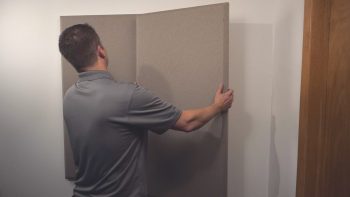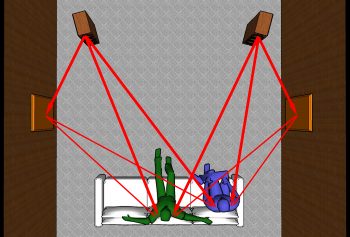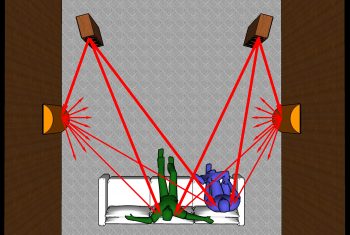How Sound Works in Rooms
Introduction
Most rooms have highly-reflective, flat walls, ceilings, and floors, and they can be a lot like echo chambers if left acoustically untreated. If you’ve ever been in an empty apartment or house, you’ll be familiar with the way sound reverberates in empty spaces.
We know that too much reverberation or echo makes for unsatisfactory acoustic experiences, but without some of it, our brains are equally frustrated in forming accurate sound images.
Why is Reflected Sound Bad?

Our video and blog, Your Brain On Sound, illustrate how acoustic environments contribute to—or detract from—our brains’ ability to construct accurate sound images. In the same way that binocular vision enables us to perceive depth of field in 3-dimensional space, the separation and orientation of our ears also enables us to accurately locate sound sources in a similar way.
Reflected sound arrives at our ears later than original, direct sound – even though both started out at the same time. Not only that, but sound travels at about 1,130 feet/second, so in a room about 18‘ long, for example, a sound wave will travel back and forth between the walls about 60 times in 1 second.
In other words, sound travels so fast, it fills a room almost instantly. And considering the fact that it also propagates in 360 degrees, it’s easy to understand how a room with bare, highly-reflective surfaces will create a nearly infinite number of sound waves all reflecting in infinite directions and colliding and interfering with each other.
All that reflected sound interferes with direct sound. While it distorts direct sound, it also generates further patterns of destructive interference – all serving to drastically diminish our listening experience.
How Can We Make Our Rooms Sound Better?
We can use absorbers to soak up some of the excess energy of reflected sound along with diffusers that help to even-out the sound – resulting in clearer, crisper, more-accurate sound imaging in our minds.
 Absorbers
Absorbers
As illustrated in our video, How Sound Works (In Rooms), you can use sound absorbers to reduce the strength of the reflected sound energy that would otherwise cause more destructive interference– but not all of it. Too much absorption makes a room sound dull, dead, and unnatural, and, typically, we don’t like overly sound-absorbent rooms.
We offer many customizable, affordable, and highly effective absorbers. Here are a few for your consideration:
NOISE S.T.O.P. FABRISORB™ fabric-wrapped wall panels are affordable fiberglass sound absorbers that deliver high performance value at an affordable cost. You can install them on nearly any wall and ceiling surface to reduce echo and reverberation. They come in many color and size combinations and do a great job of taming overly-reflective rooms.
CFAB Cellulose Sound Absorber Panels are also very cost-effective, offering great performance at a low price. They control and deaden noise and reduce airborne sound transmission. They have a Class A Fire Rating, resist mold growth, and are easy to install.
Sound Silencer™ acoustical sound panels are also Class A fire rated with both STC and NRC ratings . These panels provide high-performance sound blocking and absorption.
 Curved Surface Diffusers
Curved Surface Diffusers
Diffusers reduce the strength of flat-surface sound reflections by spreading out the sound energy, which smooths out and mitigates destructive interference patterns throughout a room. Every room presents unique acoustical challenges, depending on its size, layout, and purpose, but judicious deployment of diffusion is a critical component of any acoustical treatment strategy.
For a great demonstration of how profoundly an acoustical treatment can impact sound quality, watch our video, How Sound Works (In Rooms).You’ll notice how the acoustically-treated room maintains enough reverberation to “make sense” to our ears and brains. As we illustrate in our blog and video, Your Brain On Sound, the timing/phase of the reflected sound agrees with how and where our brains “expect” to locate the source of sound.
The CURVE System™ consists of an array of diffusers, absorbers, and corner traps that simplify the creation of professionally-accurate and natural-sounding acoustic spaces. We can help you to determine the best configuration for your work, residential, or home-entertainment rooms.
Conclusion
The right combination of diffusion and absorption will mitigate and decrease unwanted sound interference – while maintaining suitable ambience and tone. The result is much clearer, more natural, and better overall sound. Your ears and your brain will love it!
For more information and a wealth of resources, please visit https://www.acousticalsurfaces.com/.





